Risk-Based Operation and Maintenance Planning of Steam Turbine with the Long In-Service Time
Abstract
:1. Introduction
2. The Research Object and Its Operation
2.1. Critical Areas of a Steam Turbine Rotor
2.2. Crack Propagation
- —nondimensional function of geometrical parameters of the crack and the element;
- —tensile stress level in the crack area;
- —crack dimension.
- —material constants;
- —amplitude of the stress intensity factor;
- —number of fatigue cycles;
- —operation time in steady state.
- —material toughness.
- —critical crack dimension mean value;
- —actual crack dimension mean value;
- —critical crack dimension standard deviation;
- —actual crack dimension standard deviation.
2.3. Low Cycle Fatigue and Creep Processes
- —material constants;
- —strain changes;
- —number of significant strain changes during one cycle;
- —number of fatigue cycles;
- —number of hours of operation in steady-state;
- —stress during steady-state.
- —wear limit mean value;
- —actual wear mean value;
- —wear limit standard deviation;
- —actual wear standard deviation.
2.4. Steam Turbine Operation Conditions
3. Online Stress Control in the Turbine Rotor
3.1. Online Stress Monitoring Algorithm
- —coefficients determined for each stress component and for each analyzed area;
- —steam pressure;
- —rotational speed.
- —heat transfer coefficient at a given time instant;
- —heat transfer coefficient for which the Green function was determined;
- —metal temperature at a given time instant.
- —influence function for metal temperature.
- —Green’s function determined for a specific heating stage and a specific stress component.
- the indexes refer to the individual normal and shear stress components.
3.2. Stress Level Control in the Critical Rotor Areas
- index refers to the current time step;
- index refers to the previous time step.
4. Operation and Maintenance Strategy for Steam Turbine
4.1. Remaining Operation Time t = 13 Years
4.2. Remaining Operation Time t = 20 Years
- —failure probability in the period prior to preventive activities;
- —failure probability in the period after preventive activities;
- —failure-related costs;
- —preventive activity-related costs;
- —discount rate;
- —total planned service time (years);
- —year in which preventive activities are planned;
- —number of elements/risk areas/failure scenarios.
- —interest rate on the financing source (credit or own funds);
- —inflation rate.
- While operating the turbine, a stress control algorithm is used to maintain the values shown in Table 2 until preventive activities, after which all other start-ups can be carried out in the “on demand” mode.
- Corrective repair consists in the complete reduction in the crack. Then, in the calculations, it was assumed that , i.e., the crack is so small that its detection may not be possible due to the limited accuracy of the measurement methods, but its existence and further propagation cannot be ruled out. Moreover, it was assumed that after the correction was performed, the material consumption in the thermal grooves decreased to the level of 0 (by rolling the grooves, removing the degraded material layer).
- Initially, the costs of failure due to the crack propagation are 100 conventional units and due to the life-consumption processes, they are 75 conventional units. The costs of preventive maintenance for both areas of the rotor amount to 5, 15 or 30 conventional units and are paid once. The costs in the following years change due to the assumed inflation rate.
- The inflation rate was assumed at the level of (moderate inflation), the interest rate on the financing source was assumed as The real discount rate is then , which corresponds to the values dedicated for energy investments in Poland [25].
5. Conclusions
Author Contributions
Funding
Institutional Review Board Statement
Informed Consent Statement
Data Availability Statement
Conflicts of Interest
References
- Łukowicz, H.; Rusin, A. The impact of the control method of cyclic operation on the power unit efficiency and life. Energy 2018, 150, 565–574. [Google Scholar] [CrossRef]
- Rusin, A.; Wojaczek, A. Trends of changes in the Power generation system structure and their impact on the system reliability. Energy 2015, 92, 128–134. [Google Scholar] [CrossRef]
- Hübel, M.; Meinke, S.; Andr\acute{e}n, M.T.; Wedding, C.; Nocke, J.; Gierow, C.; Hassel, E.; Funkquist, J. Modelling and simulation of a coal-fired power plant for start-up optimization. Appl. Energy 2017, 208, 319–331. [Google Scholar] [CrossRef]
- Stoppato, A.; Mirandola, A.; Meneghetti, G.; Casto, E.L. On the operation strategy of steam power plants working at variable load: Technical and economic issues. Energy 2012, 37, 228–236. [Google Scholar] [CrossRef]
- Rusin, A.; Tomala, M. Steam turbine maintenance planning based on forecasting of life consumption processes and risk analysis. Eksploat. Niezawodn. Maint. Reliab. 2022, 24, 395–406. [Google Scholar] [CrossRef]
- Zhao, L.; Lin, Y. Operation and Maintenance of Coal Handling System in Thermal Power Plant. Procedia Eng. 2011, 26, 2032–2037. [Google Scholar] [CrossRef] [Green Version]
- Gabbar, H.A.; Al Jabar, S.S.; Hassan, H.A.; Ren, J. An Intelligent Experience Retention System: Challenges and Limitations for Operation and Maintenance in Nuclear Power Plants. IEEE Syst. Man Cybern. Mag. 2021, 7, 31–34. [Google Scholar] [CrossRef]
- Ikegami, T.; Shimura, T.; Koike, M. Plant Life Management and Maintenance Technologies for Nuclear Power Plants. Hitachi Rev. 2001, 50, 84–88. [Google Scholar]
- Hatti, M. Operation and Maintenance in Solar Power Plants. In Use, Operation and Maintenance of Renewable Energy Systems; Sanz-Bobi, M., Ed.; Springer International Publishing: Berlin/Heidelberg, Germany, 2014. [Google Scholar]
- Costa, Á.; Orosa, J.; Vergara, D.; Fernández-Arias, P. New Tendencies in Wind Energy Operation and Maintenance. Appl. Sci. 2021, 11, 1386. [Google Scholar] [CrossRef]
- Liu, G.; Yang, X.; Yang, X.; Liang, K.; An, D.; Wu, D.; Ren, X. Typical Damage Prediction and Reliability Analysis of Superheater Tubes in Power Station Boilers Based on Multisource Data Analysis. Energies 2022, 15, 1005. [Google Scholar] [CrossRef]
- Hardy, T.; Kakietek, S.; Halawa, K.; Mościcki, K.; Janda, T. Determination of High Temperature Corrosion Rates of Steam Boiler Evaporators Using Continuous Measurements of Flue Gas Composition and Neural Networks. Energies 2020, 13, 3134. [Google Scholar] [CrossRef]
- Feili, H.R.; Akar, N.; Lotfizadeh, H.; Bairampour, M.; Nasiri, S. Risk analysis of geothermal power plants using Failure Modes and Effects Analysis (FMEA) technique. Energy Convers. Manag. 2013, 72, 69–76. [Google Scholar] [CrossRef]
- Tomala, M.; Rusin, A.; Wojaczek, A. Risk-Based Planning of Diagnostic Testing of Turbines Operating with Increased Flexibility. Energies 2020, 13, 3464. [Google Scholar] [CrossRef]
- Rusin, A. Awaryjność, Niezawodność i Ryzyko Techniczne w Energetyce Cieplnej; Wydawnictwo Politechniki Śląskiej: Gliwice, Poland, 2008. [Google Scholar]
- British Electricity International. Turbines Generators and Associated Plant; British Electricity International: Pergamon, Turkey, 1991. [Google Scholar]
- Janssen, M.; Zuidema, J.; Wanhill, R.J.H. Fracture Mechanics; Spon Press: London, UK; New York, NY, USA, 2004. [Google Scholar]
- Crawford, R.J. Plastics Engineering; Butterworth-Heineman: Oxford, UK, 1998. [Google Scholar]
- Chang, K.-H. Computer-Aided Engineering Design; Academic Press: Cambridge, MA, USA, 2015. [Google Scholar]
- Ministerstwo Energii. Polityka Energetyczna Polski do 2040 r. (Projekt 2.1), Załącznik 2. Wnioski z Analiz Prognostycznych dla Sektora Paliwowo-Energetycznego; Ministerstwo Energii: Warsaw, Poland, 2019.
- Rusin, A.; Nowak, G.; Lipka, M. Practical algorithms for online thermal stress calculations and heating process control. J. Therm. Stresses 2014, 37, 1286–1301. [Google Scholar] [CrossRef]
- Zhang, H.; Liu, S.; Xie, D.; Xiong, Y.; Yu, Y.; Zhou, Y.; Guo, R. Online Fatigue-Monitoring Models with Consideration of Temperature Dependent Properties and Varying Heat Transfer Coefficients. Sci. Technol. Nucl. Install. 2013, 2013, 763175. [Google Scholar] [CrossRef]
- Rusin, A.; Tomala, M.; Łukowicz, H.; Nowak, G.; Kosman, W. On-Line Control of Stresses in the Power Unit Pressure Elements Taking Account of Variable Heat Transfer Conditions. Energies 2021, 14, 4708. [Google Scholar] [CrossRef]
- Krishnasamy, L.; Khan, F.; Haddara, M. Development of a risk-based maintenance (RBM) strategy for a power-generating plant. J. Loss Prev. Process Ind. 2005, 18, 69–81. [Google Scholar] [CrossRef]
- Available online: https://www.ure.gov.pl/pl/urzad/informacje-ogolne/edukacja-i-komunikacja/publikacje/seria-wydawnicza-bibli/kontrakty-dlugotermino/1306,Tabela-nr-3.html (accessed on 10 June 2022).
- Fujiyama, K.; Nagai, S.; Akikuni, Y.; Fujiwara, T.; Furuya, K.; Matsumoto, S.; Takagi, K.; Kawabata, T. Risk-based inspection and maintenance systems for steam turbines. Int. J. Press. Vessel. Pip. 2004, 81, 825–835. [Google Scholar] [CrossRef]

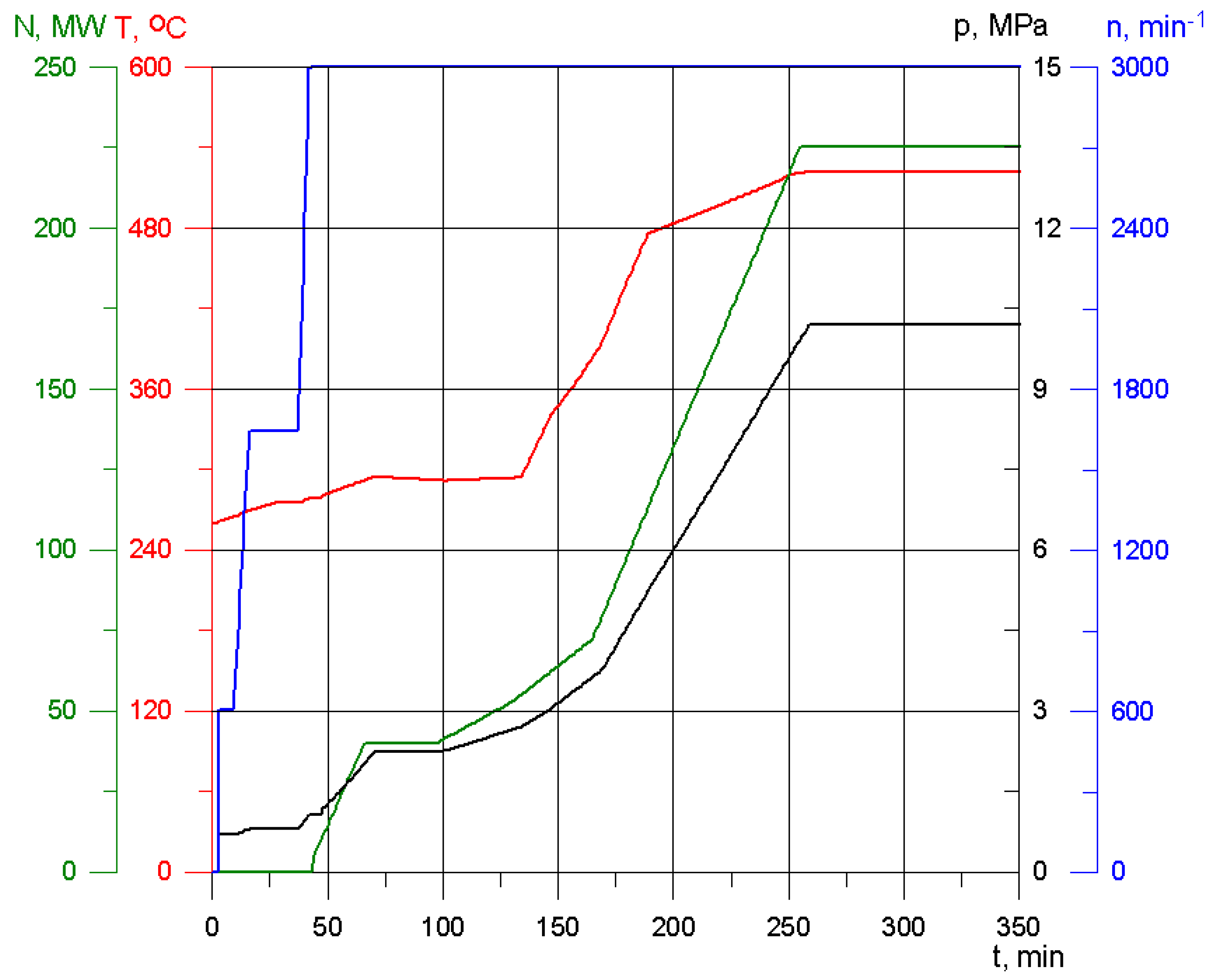
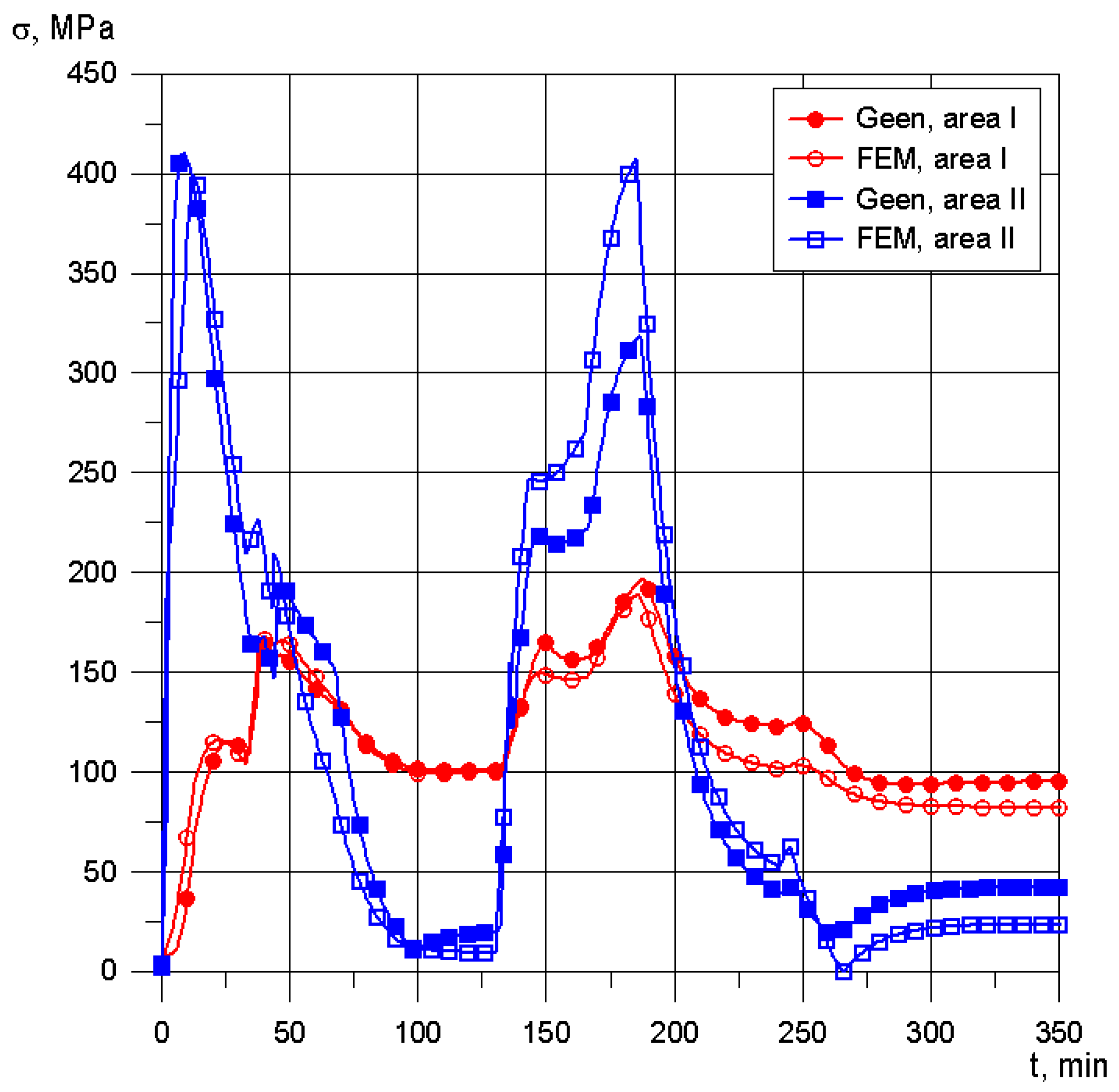

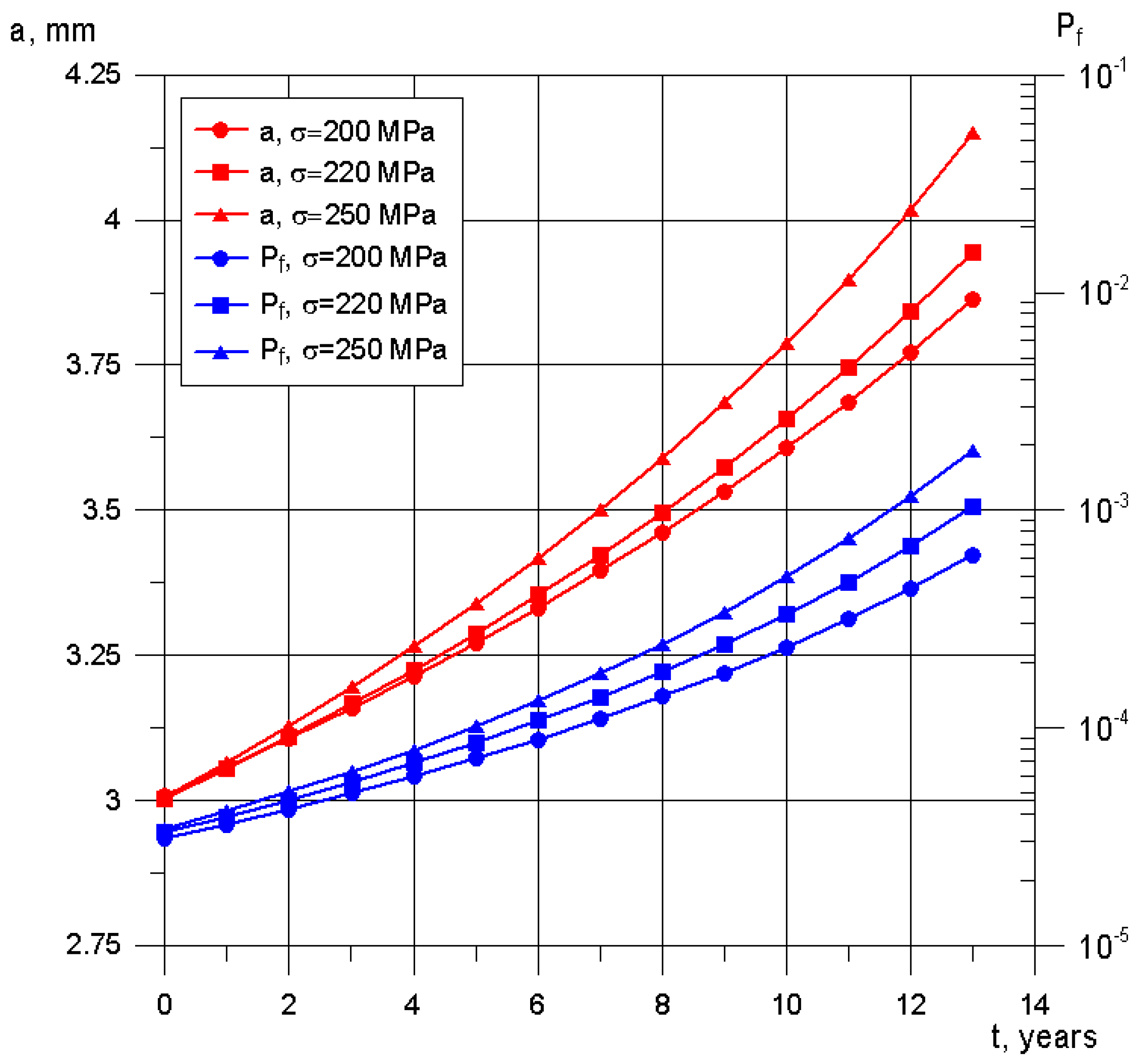
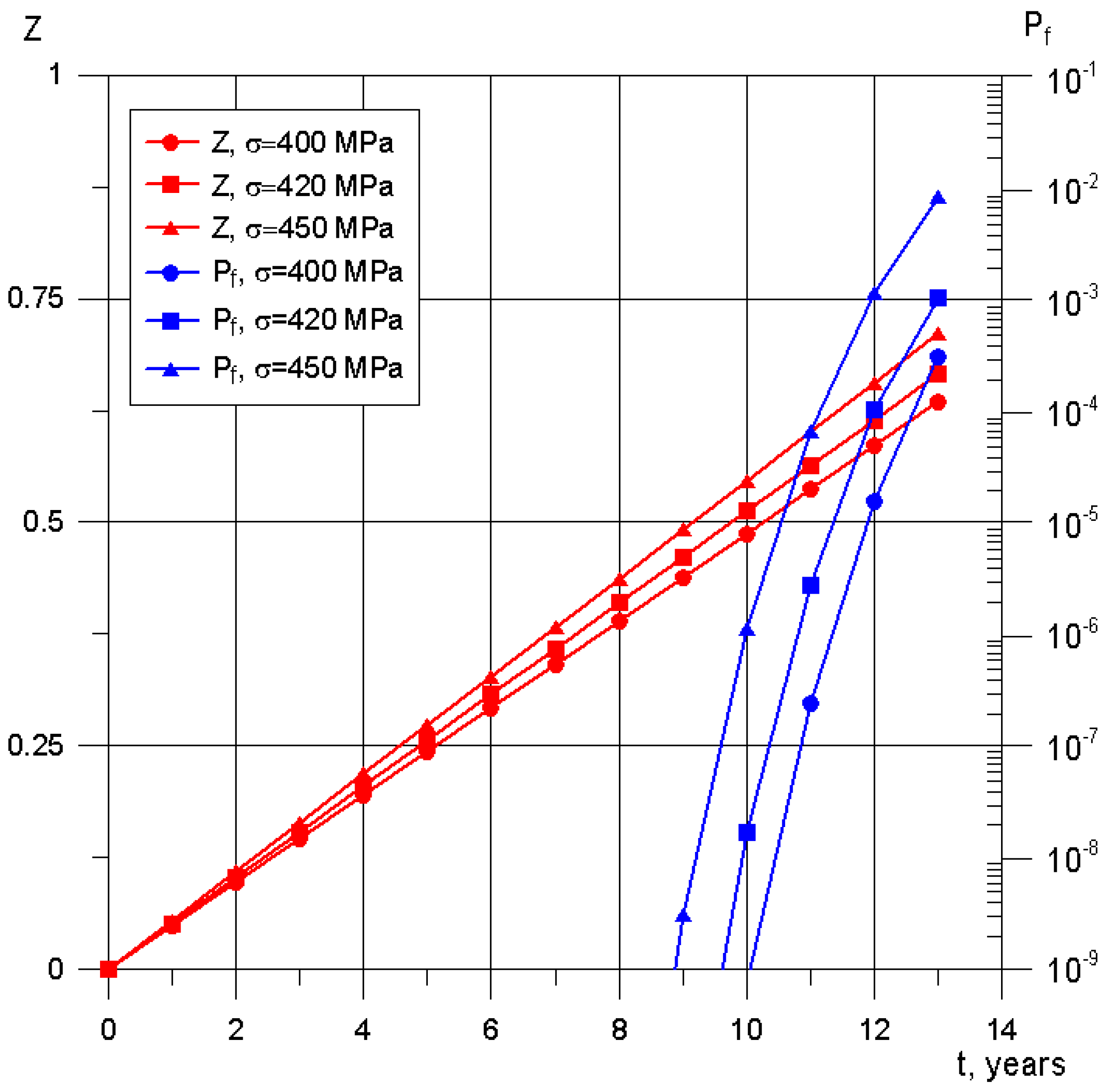
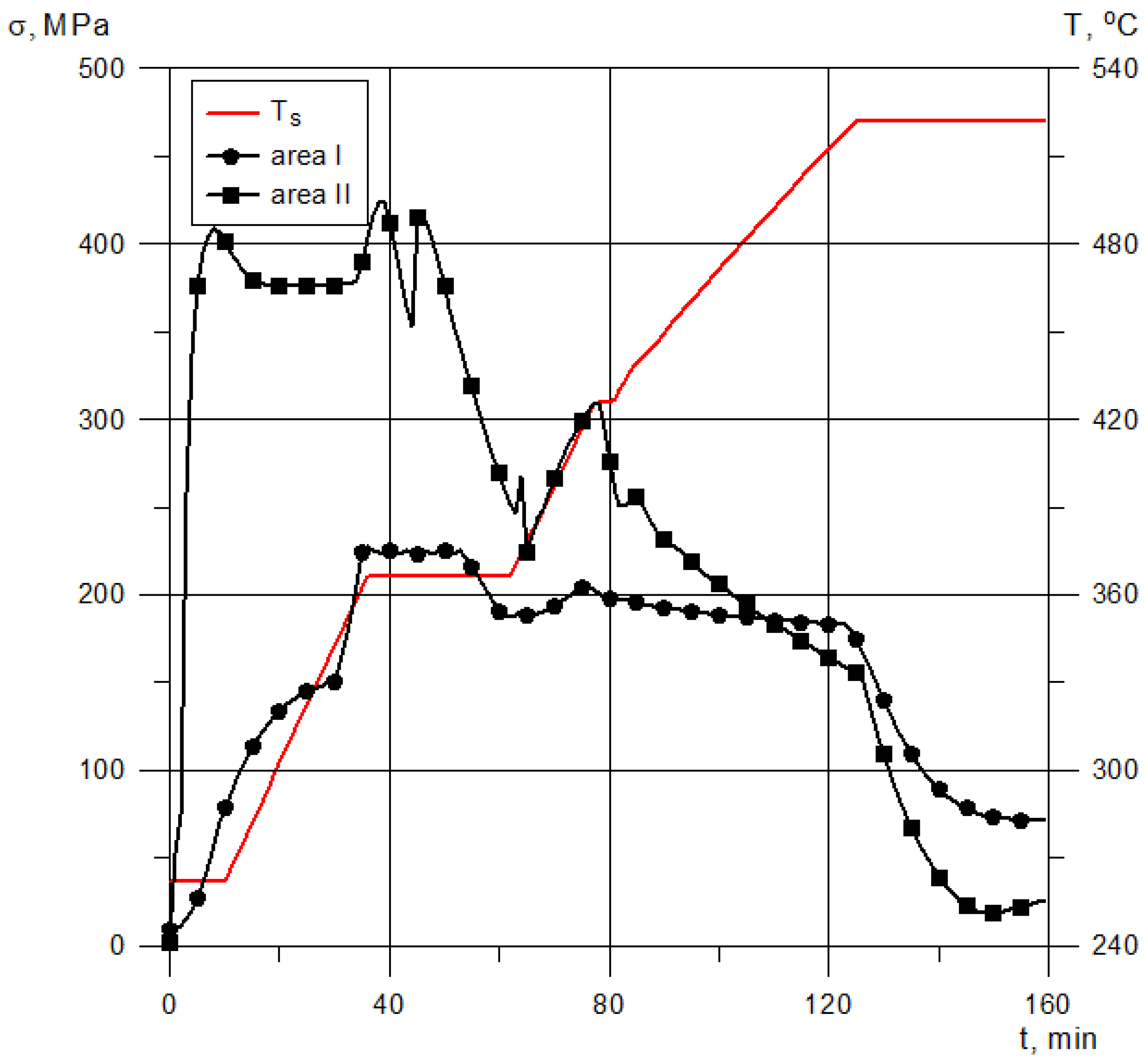
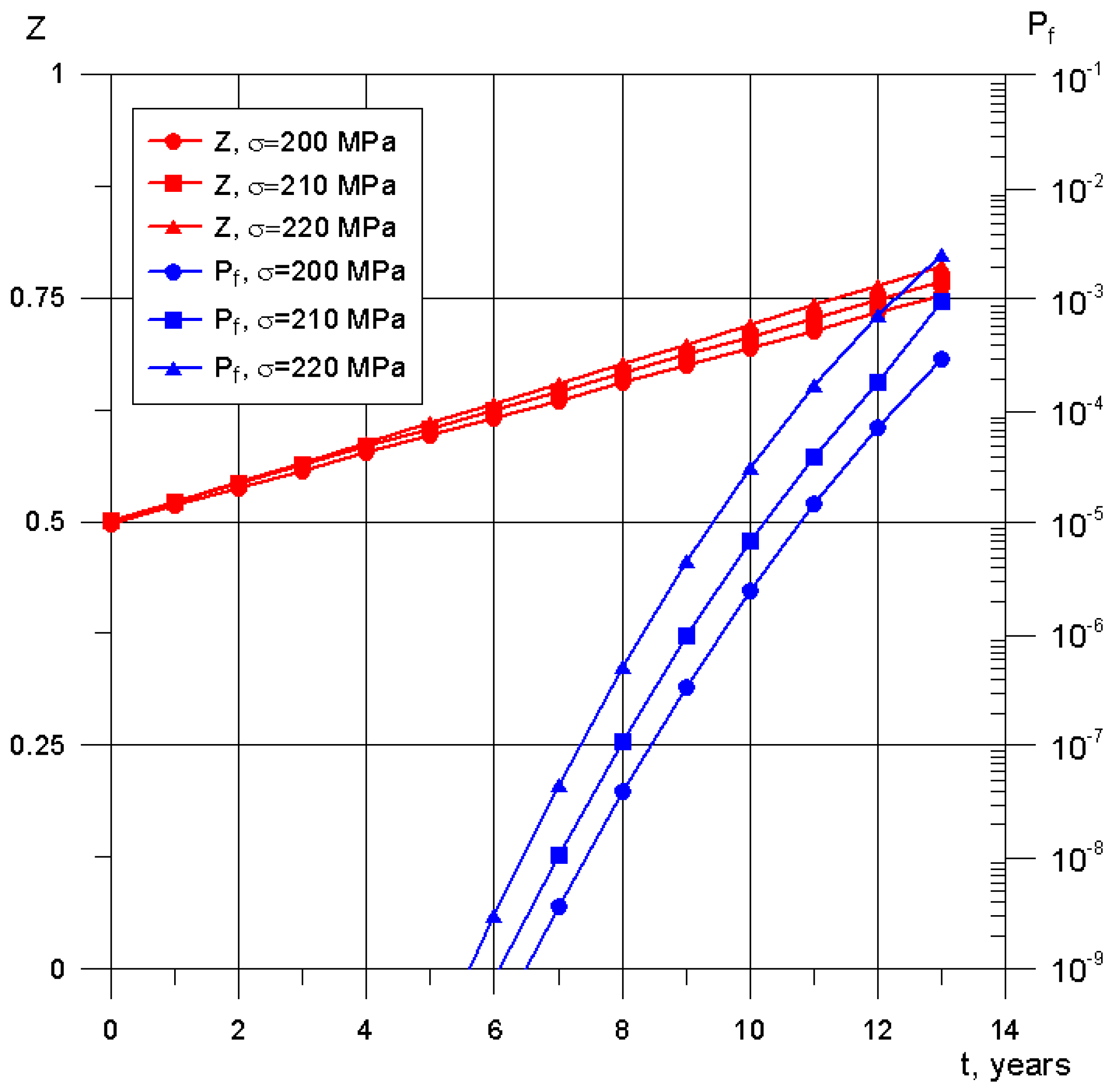

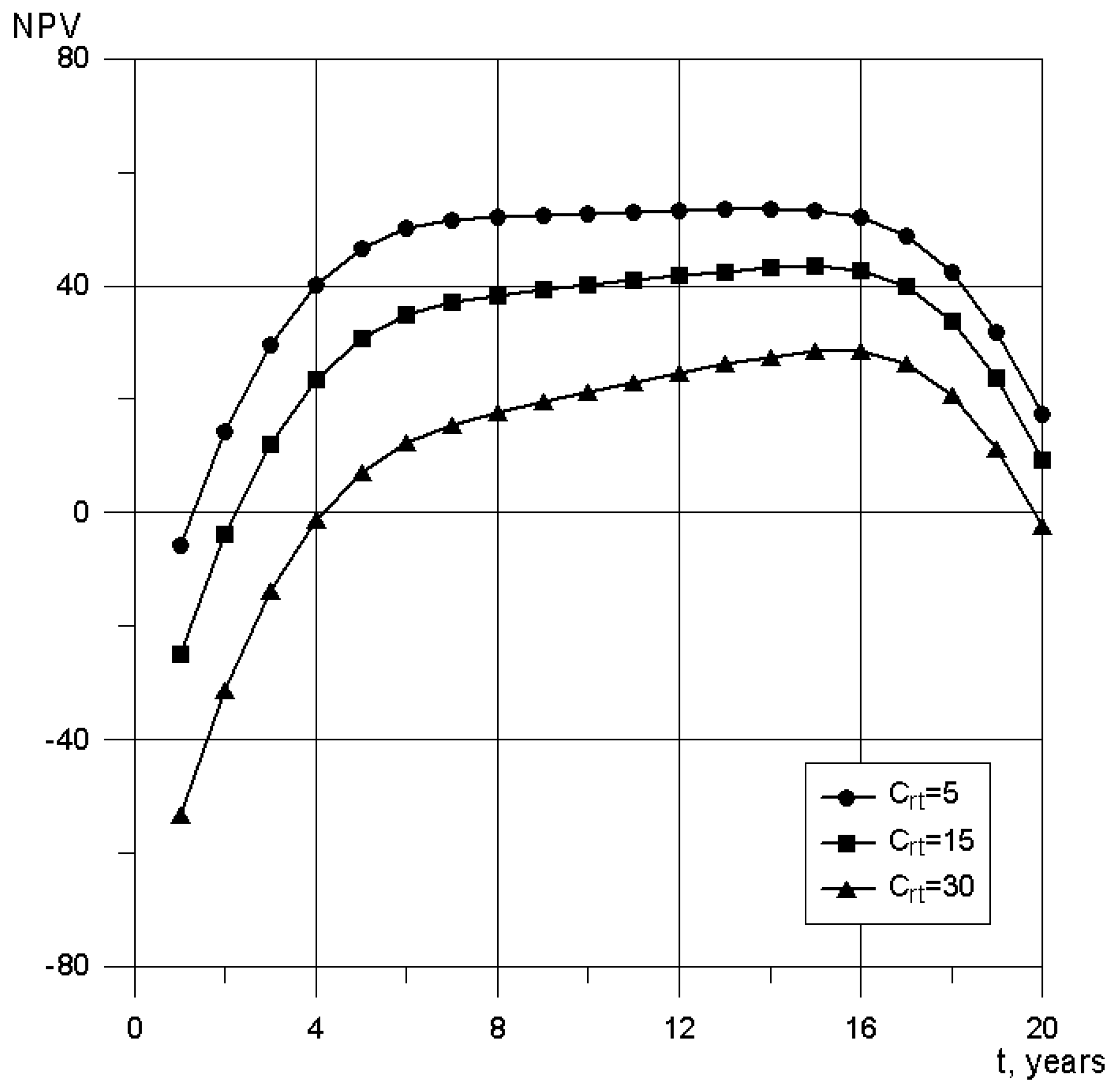

| Input Data | Mean Value | Standard Deviation |
|---|---|---|
| Crack Propagation | ||
| 2 × 10−12 | 1 × 10−13 | |
| 3.4537 | 0.173 | |
| 3 × 10−14 | 1.5 × 10−15 | |
| 5.6572 | 0.283 | |
| 300 MPa | 15 MPa | |
| 55 MPa | 2.75 MPa | |
| 3 mm | 0.5 mm | |
| 60 MPa | 3 MPa | |
| Life consumption processes | ||
| 464 | 46.4 | |
| −1.589 | −0.079 | |
| 180 GPa | 9 GPa | |
| 450 MPa | 22.5 MPa | |
| 1,000,000 h | 50,000 h | |
| 0/0.5 | /0.05 | |
| 1 | 0.03 | |
| Critical Area | “On Demand” Mode Start-Ups | Remaining Start-Ups |
|---|---|---|
| Area I (central bore) | ||
| Area II (heat groove) | ||
| Area I (central bore) | ||
| Area II (heat groove) | ||
Publisher’s Note: MDPI stays neutral with regard to jurisdictional claims in published maps and institutional affiliations. |
© 2022 by the authors. Licensee MDPI, Basel, Switzerland. This article is an open access article distributed under the terms and conditions of the Creative Commons Attribution (CC BY) license (https://creativecommons.org/licenses/by/4.0/).
Share and Cite
Tomala, M.; Rusin, A. Risk-Based Operation and Maintenance Planning of Steam Turbine with the Long In-Service Time. Energies 2022, 15, 5019. https://doi.org/10.3390/en15145019
Tomala M, Rusin A. Risk-Based Operation and Maintenance Planning of Steam Turbine with the Long In-Service Time. Energies. 2022; 15(14):5019. https://doi.org/10.3390/en15145019
Chicago/Turabian StyleTomala, Martyna, and Andrzej Rusin. 2022. "Risk-Based Operation and Maintenance Planning of Steam Turbine with the Long In-Service Time" Energies 15, no. 14: 5019. https://doi.org/10.3390/en15145019
APA StyleTomala, M., & Rusin, A. (2022). Risk-Based Operation and Maintenance Planning of Steam Turbine with the Long In-Service Time. Energies, 15(14), 5019. https://doi.org/10.3390/en15145019






